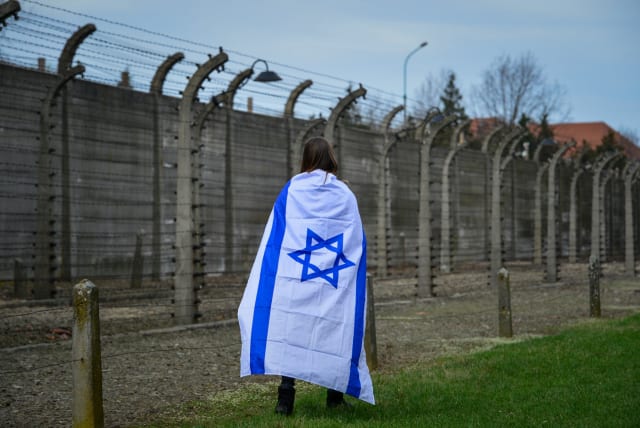Loving Jewishness with one's whole being: The head, the heart and the hands - opinion

By engaging in discussions and explorations of Jewish identity, history, experiences and practices, we awaken our consciousness to the power of Jewish Pride.
To be Jewish is a tangible thing. It is not just an idea; it is a practice and a history. It is a peoplehood, and not just a religious practice. There are real and material components which anchor Jews into their Jewish identities. To be an anchored Jew is to be able to withstand the hurricane of hate which swirls around us in the wider world.
Since publishing my first book on Jewish Pride, I have considered the following model that will support Jews in developing an empowered Jewish identity. Utilizing the Head, Hands and Heart enables us to build a sustainable Jewish Pride movement that educates, inspires, and empowers Jews all over the world to see their Jewishness as a source of pride and never of shame.
The head
To be proud of something, you have to understand it; otherwise, pride is neither developed nor rooted.
Speaking at Wilshire Boulevard Temple in Los Angeles in 2022, Jewish teenagers asked why they should be proud of their Jewishness. They were not being obtuse; rather, they were seeking to deepen their understanding of how they could participate in this movement.
The answer I gave was to understand and explore Jewish history and identity. I told them we had to dispel the notion that Judaism cannot be defined. Jewish history is substantiated by archaeology and epigraphic evidence that vividly illustrates the origins and evolution of the Jewish people in the Southern Levant, specifically the Land of Israel.

This evidence sheds light on our sense of peoplehood, one that is deeply rooted in the indigenous nature of that land. It is this crucial concept that we must instill within our community.
Contrary to what the wider world may argue, the Jewish people are not a faith; we are a distinct people with a profound and emotional connection to our indigenous land. Our history traces back at least 3,200 years, and throughout this time— including over 1,300 years of residence in the Land, with varying degrees of sovereignty—we have cultivated and preserved our civilization.
Jews today are intricately linked through a continuum of culture, practice, and belief to our ancestors from millennia ago. It is imperative that every Jew be acquainted with the basic facts of Jewish history, extending beyond the Torah and our foundational tales.
Moreover, without this knowledge, the Jewish narrative—unfolding over thousands of years—risks being shaped and interpreted solely by external perspectives. We must emphatically assert that the only people who get to define Jewish identity are Jews themselves. However, to truly embrace and take pride in our identity, we must first know our story.
The hands
Jewishness is not an abstract concept; it is deeply grounded in tangible practices and customs that reflect our heritage, which is indigenous to the land of Israel. Our pride movement must be practical and actively engaged with Jewish life.
Being Jewish transcends mere sentiment; it necessitates active participation. The term “Judaism,” first referenced as Ioudaismos in the second book of Maccabees, is said to have signified acting in the manner of the Judeans. However, due to modern (mis)interpretations of Jewishness, much of Jewish action is often framed solely through the lens of religion.
Yet, while the worship of God has always been central, the active expression of our Jewishness has encompassed much more. It has represented the very essence of our peoplehood—a distinct set of practices that distinguished us from those around us.
In his study Judaism: Practice and Belief, 63 BCE-66 CE, E. P. Sanders highlights that Judeans shared “a common set of practices and beliefs centered on Mosaic Torah and the remainder of what were jointly regarded by this time as hallowed scriptures.” It is therefore clear that modern Jews must also honor our specificity and heritage through Jewish action.
I am a secular Jew; God does not play a role in my Jewish identity. When I recite Kaddish for my late father, despite its traditional meaning, I am not exalting God. Instead, I am honoring my father in the manner that Jews have honored their deceased for over a thousand years. I am forging a connection with my ancestors and with future generations.
This idea can serve as a guiding principle for our Jewish expression. Secular Jews, in particular, must recognize that Jewish practice also belongs to them. Like our ancestors, these rituals are how we express our Jewish identities.
I emphasize again: we are not merely an abstract concept; we are a living, breathing, evolving civilization in which every Jew must actively participate. This does not imply that we will all express our Jewish identities in identical ways. Within the vast spectrum of Jewish law and tradition, each of us can discover something powerful and profound that enables us to express our Jewishness authentically.Imagine a simcha (joyous event) where every Jew in the world gathers. Picture a buffet table overflowing with a variety of delicious morsels representing different Jewish practices and traditions from around the world. Each Jew has the opportunity to rise from their seat and choose their own unique combination of Jewish expressions. This diversity is what makes our community so beautiful, but each of us must rise and choose. Simply put, to be Jewish we must act in the manner of the Jews.
The heart
Pride is indeed a feeling. We build and reinforce it through knowledge and action, yet it is a sentiment we must deliberately cultivate. By engaging in discussions and explorations of Jewish identity, history, experiences and practices, we awaken our consciousness to the power of Jewish Pride. Grounded in tangible elements, it is not a fleeting or weightless notion; rather, it is anchored at the very core of being Jewish, rooted in a profound sense of confidence and self-esteem.
While knowledge and action remain crucial, we must foster a sense of connection among individuals, the collective Jewish community, and the past, present and future of the Jewish people. Our existence today as Jews is not coincidental; it is the culmination of our ancestors’ unwavering dedication to the survival of the Jewish people. They laid the foundation and continually enriched our cultural heritage, enabling us to enjoy a vibrant and thriving Jewish culture worldwide.
Regardless of our geographical locations, all Jews are intricately linked to one another. It is through this sense of connection and belonging that we can foster a collective sense of Jewish Pride. By nurturing Jewish Peoplehood, we empower individuals to recognize their role in the broader tapestry of Jewish history, identity and expression, thereby reinforcing their pride.
The transformative power of pride has propelled a variety of communities forward, igniting a sense of healing and empowerment. Now, it is time for Jews to embrace this extraordinary force and reap its profound benefits.
Jewish Pride must be the path for our future. Through the model of the head, hands and heart, we can embrace our specificity, celebrate our heritage, unite as one people and unlock a boundless source of strength and possibility. Let us boldly embrace Jewish Pride as the guiding light that propels us towards a future of dignity, resilience, and collective empowerment. Together, we will shape a Jewish future that is vibrant and resplendent with the enduring spirit of pride.
Am Yisrael Chai.
The writer is founder of the modern Jewish Pride movement, an educator, and the author of Jewish Pride: Rebuilding a People. His new book is Reclaiming Our Story: The Pursuit of Jewish Pride.
